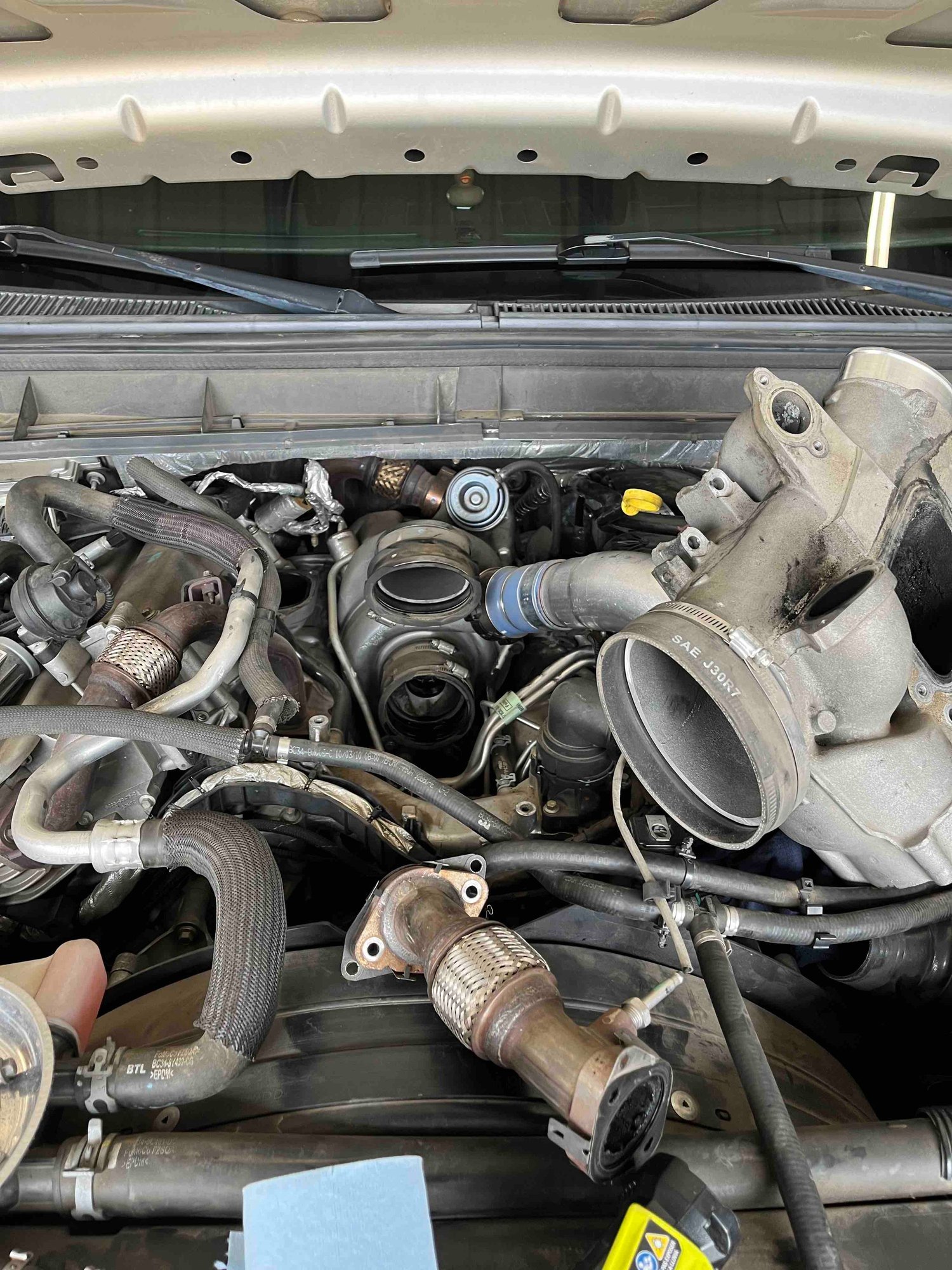P2074 6.7 Powerstroke: Troubleshooting MAP Sensor for Better Performance
Are you facing issues with your P2074 6.7 Powerstroke engine? Don’t worry; we’ve got you covered! In this guide, we will walk you through the steps to repair and optimize your Powerstroke engine for peak performance.
Owning a Ford truck equipped with the mighty 6.7L Powerstroke engine means enjoying impressive power and capability. But even these titans can experience occasional hiccups. If your dashboard lit up with the cryptic code P2074, don’t panic! This article will shed light on this code, its causes, and how to get your truck back on track.

Credit: www.carparts.com
The Importance of the P2074 Code
The P2074 trouble code in a 6.7 Powerstroke engine typically indicates an issue with the Manifold Absolute Pressure (MAP) sensor. This sensor plays a crucial role in monitoring the airflow into the engine, ensuring optimal performance and fuel efficiency.
Diagnosing the Problem
If you’re experiencing the P2074 trouble code, it’s essential to diagnose the root cause of the issue. Common culprits include a faulty MAP sensor, a malfunctioning Mass Air Flow (MAF) sensor, or a problematic Throttle Position Sensor (TPS).
Decoding P2074: A Manifold Mystery
Diagnostic Trouble Code (DTC) P2074 translates to “Manifold Absolute Pressure/Mass Air Flow – Throttle Position Correlation at Higher Load.” In simpler terms, the engine computer (PCM) has detected a discrepancy between the readings from your vehicle’s manifold absolute pressure (MAP) sensor and mass airflow (MAF) sensor, particularly when the engine is under higher load.
These sensors play a vital role in regulating the air-fuel mixture, which significantly impacts engine performance, fuel efficiency, and emissions. The PCM relies on the data from these sensors to determine how much air is entering the engine and adjust the fuel injection accordingly.
Causes of P2074 in Your 6.7L Powerstroke
Several factors can contribute to a P2074 code in your 6.7L Powerstroke:
- Faulty MAP Sensor: A malfunctioning MAP sensor might send inaccurate readings about the pressure in the intake manifold. This can confuse the PCM and lead to an improper air-fuel mixture.
- Dirty MAF Sensor: Over time, the MAF sensor can become clogged with dirt and debris, affecting its ability to measure airflow accurately. This disrupts the data sent to the PCM and can trigger a P2074 code.
- Vacuum Leaks: Leaks in the intake system can allow unmetered air to enter the engine, throwing off the air-fuel ratio calculated by the PCM. This can lead to the P2074 code and potentially other performance issues.
- Faulty Throttle Position Sensor (TPS): While less common, a malfunctioning TPS could also contribute to the P2074 code by sending incorrect data about throttle position to the PCM.
Symptoms of P2074
While a P2074 code might not always translate into noticeable problems, some symptoms to watch for include:
- Illuminated Check Engine Light (CEL): This is the most obvious sign that something is amiss with your engine’s emission control system.
- Decreased Fuel Efficiency: An improper air-fuel mixture can lead to the engine burning more fuel than necessary.
- Reduced Power: If the engine isn’t receiving the correct amount of air and fuel, it might struggle to produce its full power potential.
- Rough Idling: The engine might idle erratically due to the imbalanced air-fuel mixture.
Taming the P2074 Beast: Diagnosis and Repair
If you’re experiencing a P2074 code and its associated symptoms, here’s what you can do:
- Consult a Mechanic: While some technical information is available online, diagnosing the root cause of P2074 effectively usually requires a mechanic’s expertise and diagnostic tools.
- Common Fixes: Depending on the diagnosis, repairs might involve cleaning the MAF sensor, replacing the MAP sensor, fixing vacuum leaks, or potentially replacing the TPS.
- Software Updates: In some cases, a software update for the PCM might be necessary to address the issue.
To address the P2074 code effectively, you may need to repair or replace the faulty components. Here are the steps to follow:
1. Repair Or Replace The Manifold Absolute Pressure Sensor
Inspect the MAP sensor for any signs of damage or malfunction. If necessary, replace the sensor to restore proper functionality to your engine.
2. Repair Or Replace The Mass Air Flow Sensor
A malfunctioning MAF sensor can also trigger the P2074 code. Check the MAF sensor and replace it if needed to ensure accurate airflow readings.
3. Repair Or Replace The Throttle Position Sensor
If the TPS is causing the issue, consider repairing or replacing it to maintain optimal throttle response and engine performance.
4. Fix Vacuum Leaks
Vacuum leaks can disrupt the engine’s air-fuel mixture, leading to performance issues. Locate and repair any vacuum leaks to enhance engine efficiency.
Additional Considerations
In addition to the above steps, it’s crucial to ensure that your engine’s air intake system is in top condition. A dirty air filter or a loose cold air intake filter can also contribute to the P2074 trouble code.

Credit: www.ford-trucks.com
The Road Ahead: Keeping Your 6.7L Powerstroke Healthy
By understanding the P2074 code and its potential causes, you can be more proactive in maintaining your 6.7L Powerstroke. Regular air filter changes and scheduled maintenance can help prevent issues like dirty MAF sensors. Addressing any potential vacuum leaks promptly is also crucial. Remember, early detection and proper repairs can save you money and keep your truck running strong for miles to come.
Expert Insights
Seeking professional advice can provide valuable insights into resolving the P2074 code. Platforms like PowerStrokeArmy, Ford-Trucks.com, and JustAnswer offer expert opinions and troubleshooting tips for Powerstroke engine issues.
Frequently Asked Questions
How To Fix P2074 Code?
To fix P2074 code, repair or replace the manifold absolute pressure sensor, mass air flow sensor, and throttle position sensor. Also, address any vacuum leaks.
What Is The Code P00bd On A 6.7 Powerstroke?
The P00BD code on a 6. 7 Powerstroke indicates an issue with the Manifold Absolute Pressure (MAP) sensor. Resolve by repairing or replacing the MAP sensor, mass air flow sensor, throttle position sensor, or fixing any vacuum leaks.
What Is The Code P2a01 On A 6.7 Powerstroke?
The P2A01 code on a 6. 7 Powerstroke indicates an issue with the Manifold Absolute Pressure (MAP) sensor. It may require repairing or replacing the MAP sensor, mass air flow sensor, or throttle position sensor. Additionally, fixing any vacuum leaks could resolve the problem.
What Is The Code P0069 On A 6.7 Powerstroke?
The P0069 code on a 6. 7 Powerstroke indicates a Manifold Absolute Pressure/Mass Air Flow – Throttle Position Correlation at Higher Load. It may require repairing or replacing the manifold absolute pressure sensor, mass air flow sensor, or the faulty throttle position sensor.
Additionally, fixing a vacuum leak could also resolve the issue.
Conclusion
By addressing the P2074 trouble code promptly and following the recommended repair steps, you can unlock the full potential of your 6.7 Powerstroke engine. Keep your engine running smoothly and efficiently with proper maintenance and timely repairs.



